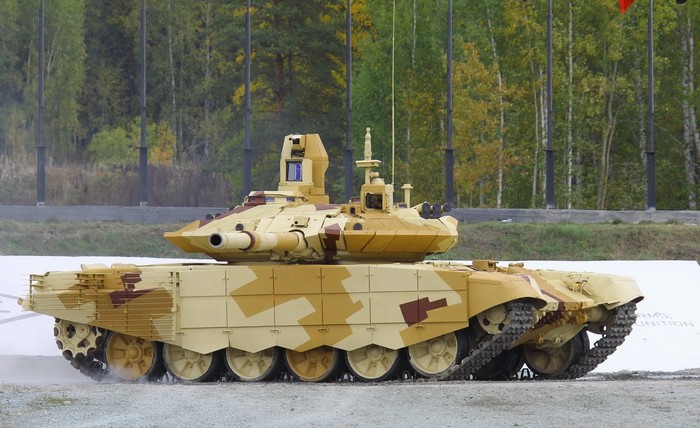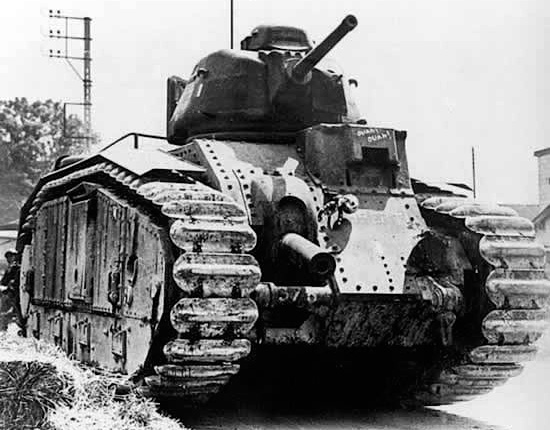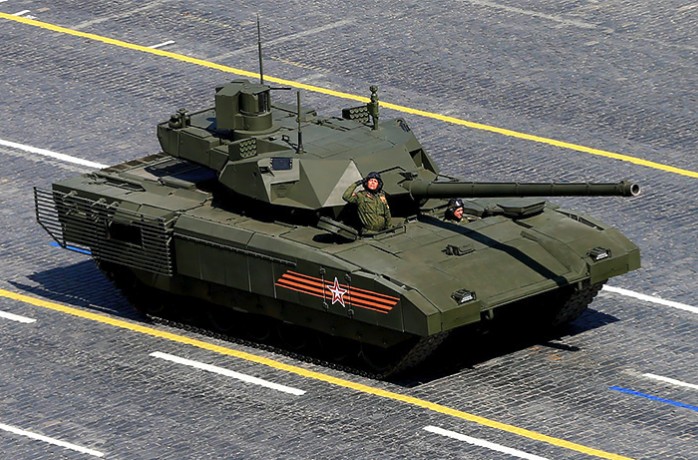Tank Leclerc Technical Specifications. The weight. Dimensions

The Char Leclerc is a main battle tank (MBT) built by GIAT, now Nexter of France. It was named in honour of General Philippe Leclerc de Hauteclocque, who led the French element of the drive towards Paris while in command of the Free French 2nd Armoured Division (2e DB) in World War II. The Leclerc is in service with the French Army and the army of the United Arab Emirates. In production since 1991, the Leclerc entered French service in 1992, replacing the AMX 30 as the country's main armoured platform. With production now complete, the French Army has 406 Leclerc and the United Arab Emirates Army has 388. The price in 2011 was €9.3 million, which made it the most expensive tank in history at the time.
Tank Leclerc - video
In 1964, studies were initiated about a possible replacement vehicle for the AMX 30: the Engin Principal Prospectif. In 1971, in view of the inferiority of the AMX 30 in comparison to the new generation of Soviet tanks about to be introduced, the Direction des Armements Terrestres ordered the beginning of the Char Futur project. In 1975, a working committee was created that in 1977 agreed on a list of specifications. In February 1980 however, a Memorandum of Understanding was signed with the Federal Republic of Germany involving the joint development of a MBT, called the Napoléon I in France and Kampfpanzer III in Germany. Fundamental disagreements about its desired configuration led to a failure of this cooperation in December 1982. It was announced that a purely French battle tank would be developed, called "EPC" (Engin Principal de Combat). The importation of foreign equipment, like the M1 Abrams, the Leopard 2, or the Merkava, had been studied and rejected.
In contrast to most Western programmes of the time, much consideration was given to active, besides passive protection, to limit the overall mass of the vehicle. Mobility for evading enemy fire and fire control systems were given particular attention. Nevertheless, it was a stated design goal to achieve at least double the protection against KE-penetrators in comparison to the level attained in then current MBTs of the fifty ton weight class, the latter indicated at about 400 mm RHA equivalency, the higher level at the same time protecting against shaped charges.

The gunner's position, looking down from the turret roof
Partnership with a foreign state was sought to limit the cost per unit, and this was found when the United Arab Emirates ordered 436 vehicles, adding to the 426 units already planned for the French Army.
In 1986, the project was started under the name of "Leclerc", six prototypes being built swiftly. Mass production started in 1990 with the four-unit Batch 1, used mainly for comparative tests in foreign countries. The 17 units of Batch 2 were shipped, with improvements in the turret and in the hull armour. These units were diagnosed with problems in the engine and suspension, and were quickly retired. Batch 3 followed with some improvements and have been used to define the doctrine of use, and instruction.
Batches 4 and 5 were better built, eliminating the recurrent problems in the powerplant, and are still in service, after having been refitted at the end of the 1990s. The second series started with Batch 6, with an added climate control system in the right rear of the turret. Batch 7 introduced a transmission system to the command vehicle, and a data system giving instantaneous vision of the state of all battle tanks and acquired targets. It also incorporated minor improvements in the visor. Batch 8 was a modernisation of the electronic system, and Batch 9 replaced the thermal imaging ATHOS by a SAGEM Iris with better resolution.

All previous batches will be modernised up to the standards of Batch 9 from 2005. In 2004, Batch 10 was presented, incorporating new information systems which could share the disposition of enemy and friendly units to all vehicles on the battlefield, and a new armor package. This was the beginning of the 96-unit third series. By 2007, 355 tanks should have been operational, 320 of them incorporated in four regiments, each of 80 Leclerc vehicles.
As of 2010, after a French defence review, each of the four regiments operated 60 Leclerc tanks for a total of 240 in operational units; with a further 100 in combat ready reserve. Due to finance cuts, only 254 tanks were fully operational in 2011.
The four regiments are:
- 1er Régiment de Chasseurs stationed near Verdun, part of the 7th Armoured Brigade
- 4e Régiment de Dragons stationed in Carnoux-en-Provence, part of the 7th Armoured Brigade
- 12e Régiment de Cuirassiers stationed in Olivet, part of the 2nd Armoured Brigade
- 501e Régiment de Chars de Combat stationed in Mourmelon-le-Grand, 2nd Armoured Brigade
A Leclerc on manoeuvres
Design
Armament
The Leclerc is equipped with a GIAT (Nexter) CN120-26 120mm smoothbore cannon. This cannon is capable of firing the same NATO standard 120mm rounds as the German Leopard 2 and US M1 Abrams, but in practice only French-produced ammunition is issued. The gun is insulated with a thermal sleeve and has an automatic compressed-air fume extraction system instead of the usual bore evacuator. The Leclerc has a unique autoloading system which was specifically designed for it, and reduces the crew to three by eliminating the human loader. The turret of the Leclerc was designed around the auto-loading system in order to avoid the problems common to other tanks with an autoloader. The Leclerc autoloader allows a rate of fire of 12 shots per minute and holds 22 rounds of ready ammunition; it can accommodate up to six different types of ammunition at once, although like most autoloader systems it cannot change ammunition types once a round has been loaded. The most common types are the armour piercing fin-stabilised discarding sabot (APFSDS) with a tungsten core and the high explosive anti-tank (HEAT) round. The gun is 52 calibres long instead of the 44 calibres common on most tanks of the Leclerc's generation, giving the rounds a higher muzzle velocity.
The Leclerc is also equipped with a 12.7 mm coaxial machine gun and a remote-controlled 7.62 mm machine gun, whereas most other NATO tanks use 7.62 mm weapons for both their coaxial and top machine gun mounts; the major exception is the American M1 Abrams, which has a 7.62 mm coaxial machine gun and two top-mounted machine guns, one 7.62 mm and one 12.7 mm.
Protection
The Leclerc has the GALIX combat vehicle protection system from GIAT, which fires a variety of smoke grenades and infra red screening rounds, as well as anti-personnel grenades.
The hull and the turret are made of welded steel fitted with modular armour, which can be replaced easily for repair or upgrade over the years. In the late 1970s, the French army rejected Chobham armour as being overly specialised in its optimisation to defeat hollow charge-weapons; it, like the Germans, opted to develop its own composite arrangement to defeat both hollow charge and sabot rounds. Due to the introduction of modernised threats, batch 3 vehicles have a new armour package, including composite armour, titanium insert and on the sides of the turret, ERA blocks.
Fire control and observation

Closeup of the front of the Leclerc's turret; the 12.7mm coaxial machine gun can be seen below and to the side of the 120mm main gun
The last 96 MBT XL Leclerc have the ICONE TIS battle management system with digital communication system which integrates data from other tanks and upper levels of command. Since 2009, all Leclerc in service (S2 and SXXI) have ICONE BMS.
The Leclerc tank features the HL-60 gunner's primary sight from SAGEM. The sight's day channel offers X3.3 and X10 magnification (X14 in case of the UAE version). The night channel thermal intensifier offers X3, X6, X10 and X20 magnifications. No emergency or auxiliary sights are mounted. The laser range finder is of the Nd:YAG type. The tank commander can observe the surroundings through 7 periscopes and the HL-70 Panoramic sight. The HL-70 is equipped with a day channel at X2.5 and X10 magnification and a night channel with X2.5 magnification. On the Series XXI and UAE variant the HL-120 and HL-80 commander's panoramic sight are mounted respectively. The sight offers X2.5 and X10 magnification (and an electronic zoom X2) for the thermal intensifier and a laser range finder of the Nd:YAG type. Both sights are also equipped with a semi auto tracker for target acquisition. The combination of the gunner's primary sight and commander's panoramic sight allows the Leclerc to operate in a hunter-killer mode.
The Leclerc's digital fire control system can be operated independently by the gunner or the commander, and it offers real time integrated imaging from all of the tank's sensors and sights, including the gunner's SAVAN 20 stabilised sight, developed by SAGEM.

Propulsion
The Leclerc has an eight-cylinder SACM (now Wärtsilä) V8X-1500 1,500 hp Hyperbar diesel engine and a Renk AG automatic transmission, with five forward and two reverse gears. The official maximum speed by road is 72 km/h and 55 km/h cross country (speeds in excess of 80 km/h were reported on road). The maximum range is given as 550 km, and can be extended to 650 km with removable external tanks. The "hyperbar" system integrates a Turbomeca TM 307B gas turbine in the engine, acting both as a turbocharger and an APU giving auxiliary power to all systems when the main engine is shut down. The Hyperbar name comes from the unusually high boost pressure of 7.5 bar and the resulting mean effective pressure of 32.1 bar. To compare, the largest diesel engine in the world (the Wärtsila RTA96) has a mean effective pressure of 18.6 bar. In addition, with boost available even at idle, this arrangement also works as an anti-lag system.
At a combat weight of just 56 tons, the Leclerc is one of the lighter main battle tanks in the world, though still considerably heavier than Soviet and later Russian designs; this gives it one of the best power-to-weight ratios among the Western tanks (27 hp per ton) and makes it one of the fastest MBTs of its generation (0 to 32 km/h in 5 seconds).
The engine exhaust, exiting at the rear left, is cooled to reduce the thermal signature of the Leclerc. Transmission is a hydromechanical type with five forward and two reverse gears. Fuel tanks carry 1,300 litres and act as extra protection for the tank; two 200-litre external tanks can be fitted on the rear of the turret, but these have to be jettisoned before entering combat, since they limit turret rotation.
The gear box is equipped with a hydrokinetic retarder, which can slow the Leclerc down at a deceleration rate of 7 m/s² (0.7 g) which is automatically used over 30 km/h.

Operational history
In service since 1992 (after the Persian Gulf War), the Leclerc has mostly seen deployment on low-intensity conflicts, including 15 Leclerc stationed in Kosovo (KFOR) and others in Lebanon (UNIFIL) within UN peace-keeping operations, where their performance was judged satisfactory by French officials.
Until 2010, 13 Leclercs were deployed in the south Lebanon for a peacekeeping mission with UNIFIL.
As of August 2015, Leclerc tanks of the United Arab Emirates were deployed in combat operations in Yemen (near Aden) as part of the Saudi-led coalition. It is estimated that 70 Leclerc MBTs were deployed by the UAE in Yemen, 15 of them equipped with the AZUR package. During one month, three tanks were damaged, two by antitank mines and one by an RPG, which damaged the grid without piercing the hull. In a single incident; one Leclerc tank was hit and penetrated in the driver's hatch by an ATGM, possibly of Konkurs or Konkurs-M type, resulting in the death of the driver and injuries to the legs of the commander. None of these tanks were completely destroyed.

Variants and upgrades
Séries 1: Original production model
Leclerc 'Flakpanzer' SPAAG: Early 1990s development of the Leclerc fitted with a turret derived from that of the German Flakpanzer Gepard. Armed with twin 35 mm Oerlikon KDA autocannons and two twin pack Mistral SAM launchers (total of four ready missiles). It was not adopted for service due to post-Cold War defence cutbacks.
Leclerc Crotale: A proposal from the same time period to fit the Crotale NG SAM system to a Leclerc chassis. Intended primarily to protect armored formations on the move against aerial attack. Again not proceeded with due to cutbacks. No prototype known to have been built.
Séries 2:
- new NBC system which integrates a hybrid air conditioner.
- independent air conditioning unit installed on the back roof behind the gunner's hatch.
- In order to balance the turret since the adding of the air conditioner, the turret frontal armor is thickened a few centimeters ahead of the commander's station.
- revised sprocket cooling fins.
- extra splash guard added to the front hull.
- Remote operated hydraulic track tensioner.
- bolt-on appliqué armor on each hull sponsons.
- Athos thermal camera on the gunner's sight is replaced by the new Iris thermal camera since the block 9 (T9).
- SIT ICONE battlefield management system added in 2009

Séries XXI:
- New composite armor package, the additional weight caused by the adding of tungsten is avoided thanks to the titanium that replace the steel previously used in each armor modules. Turret bustle modular armor includes also semi-reactive layers made of explosive materials.
- Turret storage bins have been tailored for the larger armor package.- The commander has now the HL 120 panoramic sight which now features a laser rangefinder and the Iris thermal camera.
- Higher electrical turret output.
- IFF indicator.
- SIT ICONE battlefield management system.
Leclerc AZUR Action en Zone Urbaine: proposed urban warfare kit for actions in urban areas.
Leclerc EPG Engin Principal du Génie: "main engineering vehicle": armoured engineering
Leclerc DNG Dépanneur Nouvelle Génération: recovery tank
Leclerc MARS : Moyen Adapté de Remorquage Spécifique: provisional armoured recovery vehicle prior to the arrival of the DNG.

Leclerc used by the Army Forces of United Arab Emirates
Tropicalized Leclerc (Leclerc EAU): version of the United Arab Emirates; it is fitted with :
- EuroPowerPack with the 1,100 kW MT883 diesel engine built by the German company, MTU Friedrichshafen - the United Arab Emirates has interests in this company and preferred built by them.
- Externally mounted diesel auxiliary power unit with a tank infantry telephone fitted on its armored box.
- Redesigned engine compartment (louver, access panels).
- Engine-driven mechanical air-conditioning mounted in the left part of the hull to cool the tank without the use of electric current, which could reveal the position of the tank.
- HL-80 commander panoramic sight with Alis thermal camera and laser rangefinder.
- ATO (Armement Télé-Opéré) remote-controlled mount for a 7.62 mm FN MAG machine-gun operated under-armour by the HL-80 panoramic sight.
- Leclerc Battlefield Management System (LBMS).
- Completely automated driving and turret functions with pictograms on the buttons for use by crew with only basic training.
- Thermal tarp.
- Some bustle storage bins are replaced by baskets.
Leclerc Koufra, or Leclerc T40 : A proposal from the late 2000s to convert existing Séries 1 vehicles into a 'heavy' reconnaissance scout, primarily for urban warfare. The conversion included a brand new turret incorporating a CTA CT40 Case Telescoped Weapon System (CTWS) as well as grenade launchers, along with provision for two side mounted anti-tank missiles.
Leclerc T4 : Prototype with an elongated turret built in 1996. It was armed with a 140 mm smoothbore gun designed by the arsenal of Bourges (EFAB). In order to avoid being scrapped, the prototype turret has been restored in the 2010s and mounted on a former Leclerc hull which was used in its last years as a towing vehicle. Following its restoration, the tank has been nicknamed Terminateur (Terminator) by the director of the technical section of the French Army (Section Technique de l'Armée de Terre or STAT) that made everything to preserve this technological demonstrator. In 2017, the Terminateur was presented with the experimental Scorpion camouflage.
Leclerc XLR : Newest upgrade package part of the SCORPION program. Inclusion of new tactical interfaces, new armor packages, RWS turret, as well as several additional sensors and grenade launchers. Deliveries starting in 2020.

Tactics specifications Leclerc
- In service: 1993–present
- Designed: 1983–1989Manufacturer: GIAT Industries (now Nexter)
- Produced: 1990–2008 (The last unit was produced in 2007 and the production line was closed, although Nexter retains the capability to build more if there is a need)
- No. built: ≈862
Unit cost: ₣rs104,304,000 in 1993, US$4+million in 2016
Weight: series 1: 54.5 tonnes; series 2: 56.3 tonnes; series XXI : 57.4 tonnes
Length: 9.87 m (6.88 without gun)
Width: 3.60 m
Height: 2.53 m
Crew: 3 (Commander, gunner, driver)
Armour: modular composite armor SXXI version include titanium, tungsten and semi-reactive layers.
Main armament: GIAT CN120-26/52 120mm tank gun. 40 rounds (1 round ready to fire in the chamber, 22 rounds inside the autoloader magazine with additional 18 rounds cylinder in the hull)
Secondary armament
- 12.7 mm coaxial M2HB machine gun (1,100 rounds)
- 7.62 mm machine gun (3,000 rounds)
Engine: V8X SACM (Wärtsilä)8-cylinder diesel engine 1,100 kW (1,500 hp)
Power/weight: 27.52 hp/tonne
Transmission: Automatic SESM ESM 500
Suspension: hydropneumatic
Fuel capacity: 1300 litres (1700 ℓ with fuel drums)
Operational range: 550 km, 650 km (400 mi) with external fuel
Speed: 72 km/h (45 mph)

AZUR - modification of the tank, optimized for military operations in the city

Tank Leclerc with a 140-millimeter cannon

Tank Leclerc with a 140-millimeter cannon



Tank AMX-56 Leclerc UAE in deserted camouflage





















































